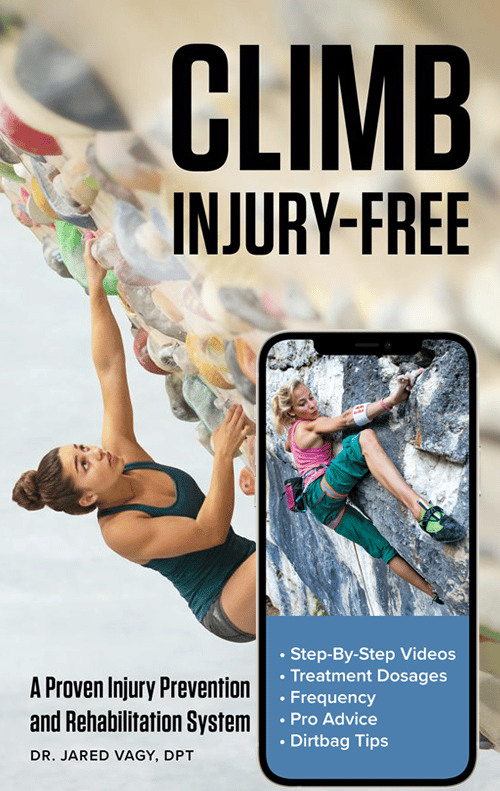S3, E3: How to Prevent and Recover from Meniscus Injury – Joshua Foster
In this conversation, Jared Vagy and Josh Foster discuss meniscal injuries in rock climbers. They explain what a meniscal injury is and how climbers can injure their meniscus. They discuss the signs and symptoms of a meniscal injury and how it is diagnosed and treated. They also outline a rehabilitation plan for meniscal injuries, including exercises to restore range of motion and strengthen the muscles around the knee. They emphasize the importance of proper movement patterns and provide climbing-specific exercises to prevent meniscal injuries in climbers.
Joshua Foster’s Bio
Josh Foster is a Doctor of Physical Therapy with a passion for movement and health, beginning his journey in 2001 when he discovered climbing. He has been deeply embedded in the climbing community for over 20 years, starting as a youth competitor who reached the national level in high school. He spent 12 years setting routes and more than a decade as a youth competitive climbing coach, where he facilitated success for new athletes and national champions.
Josh’s calling to physical therapy emerged after he sustained injuries requiring surgery and extensive rehabilitation. Experiencing firsthand the impact a great physical therapist can have, he dedicated himself to an evidence-based physical therapy practice to help others return to the activities that inspire them.
As a climbing coach, Josh developed a refined ability to assess and articulate complex movement patterns for athletes of varying skill levels. This coaching background enhanced his skills as a physical therapist, teaching him to listen closely and collaborate with his clients to uncover their motivations and support them in achieving their goals. He believes that setting both short-term and long-term goals leads to the most successful outcomes.
Josh’s training as a physical therapist, combined with his experience as a high-level coach, enables him to work closely with clients to develop focused, collaborative, and effective treatment plans, supporting them in returning to their lives and reaching their aspirations.
Driven by the discoveries and complexities of movement in natural environments—from climbing technical 14,000-foot peaks to exploring river canyons—Josh’s goal as a physical therapist is to guide others in achieving better movement in their chosen environments. He fosters a healthy, positive, and enjoyable atmosphere to encourage and inspire movement.
Takeaways
- Meniscal injuries can occur in climbers due to the high load and twisting motions placed on the knee during climbing movements.
- Signs of a meniscal injury include joint line pain, clicking or popping, difficulty bending or straightening the knee, and swelling.
- Diagnosis of a meniscal injury involves a physical examination and special tests to provoke symptoms.
- Rehabilitation for meniscal injuries focuses on managing symptoms, restoring range of motion, and strengthening the muscles around the knee.
- Preventing meniscal injuries in climbers involves maintaining proper movement patterns, strengthening the muscles around the knee, and practicing climbing-specific exercises.
Listen on Apple Podcasts, Spotify, or wherever you listen to podcasts!
Timecodes
-
00:00 Introduction
-
01:23 What is a meniscal injury and how do climbers get them?
-
06:52 Diagnosis and treatment of meniscal injuries
-
09:00 Rehabilitation plan for meniscal injuries
-
22:47 Movement patterns and climbing-specific exercises
-
30:35 Preventing meniscal injuries in climbers
If you would like to listen to the entire interview with Joshua Foster, check out the podcast. If you want to watch the interview, click the YouTube link or any of the timestamps above. If you would like to read quick sample of a concise recap of key interview topics and questions, check out the excerpt from the interview below.
Understanding Meniscal Injuries in Climbing: A Guide with Josh Foster, PT
Josh, could you start with an introduction for those who may not know you?
Of course. I’m Josh Foster, a climbing physical therapist. I spent over a decade setting climbing routes and working as a youth competitive climbing coach. I’m passionate about helping climbers with their injuries and keeping our community healthy.
This episode focuses on knee injuries, especially meniscal injuries, in climbers. Could you start by explaining what the meniscus is and why it matters for climbers?
Sure! The meniscus is a piece of cartilage between the tibia (shin bone) and femur (thigh bone) in the knee. It provides cushioning and support for the knee joint, which is essential for activities like climbing that place a lot of load on the knee through moves like heel hooks, high steps, drop knees, and back steps.
How do climbers typically injure their meniscus?
The classic mechanism for a meniscal injury is a combination of knee compression, twisting, and bending. Climbers put significant load on the knee with high steps, drop knees, and especially extreme heel hooks. A sudden twist, or even repetitive landing, can increase the risk. Climbers with a history of knee injuries, like previous strains or issues from other sports, may also be more susceptible.
What are common signs of a meniscal injury in climbers?
Classic signs include pain along the joint line, usually on the inside or outside of the knee, clicking or popping sounds, and sometimes even a sensation of the knee locking in place. Swelling can also occur, especially if the injury is more severe.
Could you clarify what “joint line” pain means for those who may not be familiar with anatomy?
Absolutely. If you feel around the knee cap (patella), you’ll notice a slight depression beneath it. That’s the joint line area, which is where pain from meniscal injuries typically shows up. Joint line pain can indicate damage to either the medial (inside) or lateral (outside) meniscus, though there are other structures around the knee that can also cause pain in that area.
What steps would a medical provider take to confirm a meniscal injury?
Initially, they’d check for the common signs like joint line tenderness, clicking, and popping. Then, they might use a few special tests to reproduce the injury mechanism – some twisting and bending motions to see if they can elicit the same symptoms. An MRI could be used if the suspicion is high, but often, these tests and physical assessment are enough to start a rehab plan.
Can you outline the rehab process for climbers with a meniscal injury?
Absolutely. Here’s a general breakdown of the stages:
- Symptom Management: Start by managing pain and swelling. Basic exercises like ankle pumps and gentle knee movements help keep things calm.
- Restore Mobility: Regaining knee extension is crucial, as a fully extended knee supports walking and everyday functions. We often start with heel slides for bending and terminal knee extensions for straightening.
- Early Strengthening: This includes “quad sets” to engage the quadriceps. Although simple, these exercises restore the brain-muscle connection, which can be lost after injury.
- Progressive Strengthening: Exercises like bridges and single-leg deadlifts (RDLs) come into play. These focus on hamstrings and glutes to support knee stability and control, critical for climbers.
- Movement Practice: Finally, translating strength gains to the wall is essential. Practicing high steps and drop knees with one foot on the ground helps gradually rebuild confidence and strength in climbing-specific movements.
Some might see quad sets as too simple. Is there value in these exercises?
Definitely. While quad sets may appear basic, they’re critical for reestablishing the connection between the brain and the muscles. After an injury, it’s common to lose that ability to fully activate the quads, which support knee extension. Without this foundational step, the muscle can start to atrophy, leading to longer-term issues.
Why are the quadriceps so important after a meniscal injury?
The quads stabilize the knee joint and control bending and straightening. They also provide strength to support knee function, which is essential in climbing. Without strong quads, it’s tough to balance on one leg or lift your body weight effectively. So, even though climbers focus a lot on upper body strength, lower body strength is equally important.
How do you progress from initial strength exercises to more challenging ones?
We start adding more load and complexity. For example, bridges are great for engaging the posterior chain (glutes and hamstrings). These can progress to single-leg variations, where control and balance come into play, similar to the demands in climbing. Then we move on to exercises like single-leg deadlifts and pistol squats, which develop single-leg strength and control.
Can you describe a single-leg Romanian deadlift (RDL) and its benefits?
A single-leg RDL is a hinge movement that loads the hamstrings and glutes on one leg. Start by balancing on one leg with a slight bend in the knee. As you hinge forward, keep the knee stable over the foot and let the torso lean forward while the opposite leg extends behind you. It’s a fantastic exercise for balance and strength, mimicking the single-leg stance often needed in climbing.
How do you progress into more climbing-specific movements in the rehab process?
Moving to the wall, I recommend starting with minimal load. Place one foot on the wall and practice high-step positions with the other foot grounded. This way, climbers can rehearse movements like rocking over the knee or stabilizing in a high step. This progression allows them to focus on control without the fear of full load, which is crucial for confidence as well as strength.
For those progressing well, what are the next steps on the wall?
Next, practice the high step with both feet on the wall but avoid making large movements. Just practicing shifting weight onto the high step helps with balance and stability without the full load of climbing. The focus is on control and activating the muscles we strengthened earlier—like the glutes, quads, and hamstrings.
Do you have any tips on movement control and positioning on the wall?
Yes, definitely. Climbers often rotate their knees during movements like drop knees or heel hooks. Without proper control, this rotational force can load the meniscus and risk injury. Strengthening the medial (inner) hamstrings helps stabilize the knee and counterbalance the lateral (outer) hamstrings. This rotational stability is key for climbing, especially for high load or technical moves.
Are these exercises helpful for preventing knee injuries in climbing, even if someone isn’t injured?
Absolutely. Preventing injury starts with strength and control. Studies show that competitive climbers, who often train lower-body strength and neuromuscular control, have fewer knee injuries than recreational climbers. Developing strength in the lower body and practicing controlled movements can reduce the risk of meniscal injuries and improve overall climbing performance.
What are your final thoughts for climbers regarding knee injuries and meniscal health?
My main takeaway is to encourage climbers to build lower body strength and movement control before an injury happens. Being proactive about lower body training—especially for high-intensity, high-load movements—can keep climbers strong and help prevent knee injuries. It’s not only about climbing harder but doing so safely and sustainably.
Where can listeners find you if they want to learn more or work with you?
I’m currently practicing at PT Revolution in South Lake Tahoe, but I also consult with climbers remotely. Climbing and movement health are my passion, so feel free to reach out if you’d like guidance!
- Disclaimer – The content here is designed for information & education purposes only and the content is not intended for medical advice.




